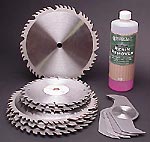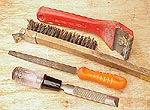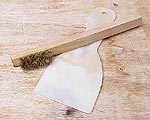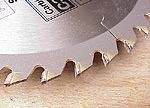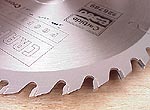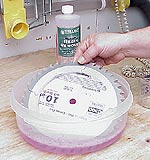This is a Veteran Owned site
| |
||
Cleaning Circular Saw Blades
Simple maintenance - Extended performanceText and photos by Tom Hintz Warning: Blades are subjected to tremendous forces during use and doing anything that compromises it's integrity could spell disaster. Using any kind of metal scraper, file or steel bristled brush is not a good idea. If scrubbing or scraping during cleaning is necessary, use plastic, non-marring implements. Taking a chance with your safety is simply not worth it.Blades for table, radial arm and miter saws represent a sizeable expense in the hobbyist woodworking shop. Most woodworkers extend the useable life of their blades by having them re-sharpened. Unfortunately, many fail to take advantage of another performance-enhancing procedure they can do themselves to maintain performance while extending the time between visits to the sharpener or replacement. During use, blades become contaminated with pitch, sap and other wood-based materials that cling to the teeth and surrounding areas of the blade body. If not removed, these contaminants increase friction that in turn generates higher levels of heat. They also insulate the blade, preventing the normal dissipation of heat, increasing heat build up even more. Excessive heat not only accelerates the dulling process, it could cause the blade to warp or otherwise distort during use, increasing the chances of binding or kickback. A dirty blade often acts dull; sometimes needing more push-through force, slower feed rates, and it could even generate smoke. There have been many good blades discarded when a simple cleaning could have reclaimed much of its useable life. Think While CleaningBefore all else, be certain no damage is inflicted on the blade (or yourself) during cleaning. Remember that whatever you do to the blade now, will be spinning in front of you when in use. I use nothing harder than a plastic scraper and brass-bristled brush on my blades. Using these "soft" tools" adds little or no appreciable work or time to the process, but does provide peace of mind knowing I have not done anything to compromise the integrity of my blade. I received an email from a novice woodworker describing his success in cleaning a badly contaminated blade. In the first paragraph of the email, I knew he was in trouble. He removed the stubborn build up by filing the edges of the gullets until the residue was removed and the metal was shinny. He also used a paint scraper to dislodge the more stubborn residue from the sides of the blade body. As fast as I could reply I warned him the blade could be dangerous and suggested he contact the manufacturer for their opinion. They advised throwing the blade (and file) away, after bending the blade so it could not be retrieved from the trash by some unsuspecting individual with a saw. It is also important to remember that edges designed to cut wood, even if dull for that purpose, will still cut human flesh easily. Be careful whenever handling a saw blade, and especially when scrubbing or wiping one down during cleaning to avoid cutting yourself! Choosing Cleaning ProductsThere are many products that will clean blades with varying degrees of effectiveness. Everything from mineral spirits to household oven cleaners can be used, but each has liabilities. There are also specially formulated fluids for cleaning blades that are effective, safe, and inexpensive. Like many woodworkers, I tried several cleaning materials and methods before arriving at the procedure I now employ. Common Cleaning MaterialsDepending on the severity of the residue build up, some household cleaners may be effective. I personally have tried a common household pine-based cleaner, applied full strength to a lightly contaminated blade with marginal results. The residue did come off with multiple applications interspersed by a little intense scrubbing with a nylon pad. Kerosene can be used as a blade cleaner, but remember the flammability issues associated with this material. Soak the blade over night in a vented container and the blade should come clean, perhaps with a little scrubbing of the stubborn spots. One household cleaner has caught the attention of at least one blade manufacturer. Charles McCracken, of Freud, Inc. said, "We recently started doing so testing with Simple Green concentrate and have found it to be very effective, too." Coated BladesThere are many blades on the market that feature coatings designed to improve their performance by reducing friction and residue build up. If your blade has a coating, make sure whatever you use to clean them is compatible with that coating. McCracken says of Freud Teflon coated blades, "Soap and water usually cleans very well. Kerosene can be used for more stubborn build up around the teeth if necessary." If scrubbing of a coated blade is needed to loosen residue, household scrubbing pads designed for use with Teflon coated cooking utensils will help prevent marring your blade coating. Make sure to keep cleaning pads used in the woodshop separate so they are not accidentally returned to use around food. Spray-On CleanersThere are a number of spray-on cleaners, many of which are very similar to oven cleaners. Oven cleaners often contain corrosive additives that can make their use on at least some blade types dangerous. Freud's McCracken warns about the dangers of using caustic substances such as oven cleaner and some of the commercially available blade cleaners. McCracken states, "These attack the binder in the carbide and, on Freud blades, they also deteriorate the special tri-metal brazing we use. This can cause carbide or brazing failure and could lead to injury." If you choose to use a spray-on cleaner containing corrosive ingredients, be sure to read all the warnings on the label. There are plenty. These cleaners are often capable of damaging many surfaces, including the human body, making it important to cover everything in the area and to protect your skin very well. The label on the woodworking spray cleaner I have describes enough hazardous materials, including liquefied petroleum gas, to warrant their suggesting it be stored under lock and key. Oddly, the label also boasts it contains no ozone depleting chemicals. This apparently does not take into account the fireball the can is capable of generating if used inappropriately. An annoying trait of spray cleaners is a tendency to dry up before the prescribed amount of soaking time necessary to loosen the residue from the blade. The instructions on the spray-on product I have say to apply the cleaner to the blade and then wait about five minutes before wiping clean. The problem is that the cleaner dried up in about three minutes (yes I timed it for this article) and required a second application to dissolve the first one so they both could be wiped off. So far, my experimentations had identified several blade-cleaning substances that left me wanting. Then, as so often happens, I stumbled upon the solution - literally. Soak Your Blades CleanDuring a visit to the local Woodcraft store, I noticed their Woodcraft brand Resin Remover, a blade cleaning concentrate that is diluted in water. The solution can be brushed on the blade, or the blade submerged and soaked in the solution to clean it. The main reason I bought it was the lack of dire warnings on the label along with no corrosive ingredients. Now we're talking. My wife provided (permanently, it will not be used for food again) a large, covered, round plastic container with an inside dimension slightly larger than my 10-inch saw blades. I mixed a batch of the solution according to the directions; four parts water to one part cleaner, submerged my radial arm saw blade, the dirtiest I in my shop, and then waited 15 minutes. Presto! Clean blade. All of the residue had flaked off in the cleaning solution. After flushing the blade with clear water, I noticed that even the stubborn build up surrounding the carbide teeth was gone, with no scrubbing or scraping. All that was needed was a light coat of WD-40 before re-installing it in the RAS. Next, I submerged my SystiMatic table saw blade, also for 15 minutes, with the same results. Soak, flush with water, dry, and give it a light coat of WD-40. No muss, no fuss. Perfectly clean blades with no scrubbing or other undue exertion by a decidedly happy woodworker. If you cut wood with a heavy sap or pitch content cleaning may require extended soaking time, or some scrubbing to completely remove the residue. Stubborn spots can be loosened with a brass-bristled brush or plastic scraper. So far, I have cleaned four 10-inch blades and my stacked dado set in the one batch of solution. To this point there has been no appreciable loss of effectiveness. The bottle contains enough concentrate to mix four batches (each batch is five cups in total volume) rendering the $10.99 purchase price nearly irrelevant. My only concern with the residue removing solution is it's pink coloring that could look like a drink to children. With the huge range of drink colors on the market I doubt there is a safe coloring that could be used so, as with all chemicals, take care to store this cleaner out of the reach of children. Clean RegularlyBlade cleaning will be much easier if done on a regular schedule, before the residue becomes thick or baked on by the heat it generates. Like many maintenance chores, keeping up with blade cleaning will improve its performance and extend the useable life. There are more blade cleaners than the ones described in this article and one not mentioned here may suit your needs. I strongly suggest considering the purpose-designed cleaning solutions. In my shop, using a product with very low flammability potential that cleans well and does not damage expensive blades is important. My blades cut cleaner, longer and need sharpening less often. That means I can stay in the shop a little longer which is the point of all this in the first place. Do you have a comment about this page? - Email Me! Back to the Tips & Tricks List
|
All written, photographic and drawn materials are property of and copyright by NewWoodworker.com LLC 2000-2019. Materials may not be used in any way without the written permission of the owner.

